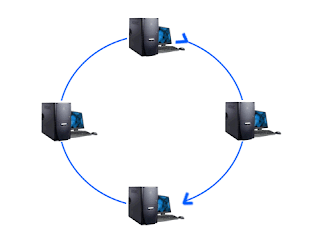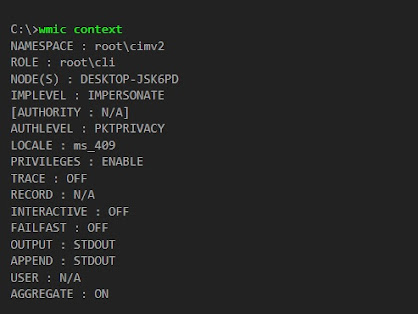Media and Topologies
The following logical or physical Network Topologies given a schematic diagram or description:
Ethernet Networks
In the diagram below
you will see two Ethernet configurations. On the left the computers are
connected together with a single cable coming from the router/switch, this is
called a bus or thin Ethernet configuration.
In bus Topologies, all
computers are connected to a single cable or "trunk or backbone", by
a transceiver either directly or by using a short drop cable. All ends of the
cable must be terminated, that is plugged into a device such as a computer or
terminator. Most bus Topologies use coax cables. The number of
computers on a bus network will affect network performance, since only one
computer at a time can send data, the more computers you have on the network
the more computers there will be waiting send data. A line break at any point
along the trunk cable will result in total network failure.
Computers on a bus
only listen for data being sent they do not move data from one computer to the
next, this is called passive topology.
On the right side of
the diagram each computer connects directly to the router/switch. this is how
most Ethernet's are configured today. In this topology management of the network
is made much easier (such as adding and removing devices), because of the
central point. However because it is centralized more cable is required. If one
computer fails the network will continue to function. If computers are
connected in a row, along a single cable this is called a bus topology, if they
branch out from a single junction or hub this is known as a star topology. When
computers are connected to a cable that forms a continuous loop this is called
a ring topology.
Bus Topology
In bus topologies, all computers are connected to a single cable or "trunk or backbone", by a transceiver either directly or by using a short drop cable. All ends of the cable must be terminated, that is plugged into a device such as a computer or terminator. Most bus topologies use coax cables.
The number of computers on a bus network will affect network performance, since only one computer at a time can send data, the more computers you have on the network the more computers there will be waiting send data. A line break at any point along the trunk cable will result in total network failure. Computers on a bus only listen for data being sent they do not move data from one computer to the next, this is called passive topology.
Advantages
- Easy to implement and extend
- Requires less cable length than a star topology
- Well suited for temporary or small networks not requiring high speeds(quick setup)
- Initially less expensive than other topologies
Disadvantages
- Difficult to administer/troubleshoot.
- Limited cable length and number of stations.
- If there is a problem with the cable, the entire network goes down.
- Maintenance costs may be higher in the long run.
- Performance degrades as additional computers are added or on heavy traffic.
- Low security (all computers on the bus can see all data transmissions).
- Proper termination is required.(loop must be in closed path).
- If one node fails, the whole network will shut down.
- If many computers are attached, the amount of data flowing causes the network to slow down.
Star Topology
Star networks are one of the most
common computer network topologies. In its simplest form, a star network
consists of one central switch, hub or computer which acts as a router to
transmit messages. If the central node is passive, the originating node must be
able to tolerate the reception of an echo of its own transmission, delayed by
the two-way transmission time (i.e. to and from the central node) plus any
delay generated in the central node. An active star network has an active
central node that usually has the means to prevent echo-related problems.
The star topology reduces the chance
of network failure by connecting all of the systems to a central node. When
applied to a bus-based network, this central hub rebroadcasts all transmissions
received from any peripheral node to all peripheral nodes on the network,
sometimes including the originating node. All peripheral nodes may thus
communicate with all others by transmitting to, and receiving from, the central
node only. The failure of a transmission line linking any peripheral node to
the central node will result in the isolation of that peripheral node from all
others, but the rest of the systems will be unaffected.
Advantages of a Star Network
- Good performance.
- Easy to set up and to expand.
- Any non-centralized failure will have very little
effect on the network, whereas on a ring network it would all fail with
one fault.
- Easy to detect faults
- Data Packets are sent quickly as they do not have to
travel through any unnecessary nodes.
Disadvantages of a Star Network
- Expensive to install
- Extra hardware required
- If the host computer fails the entire system is
affected.
Hierarchical Topology
(also known as Tree)
The type of network topology in
which a central 'root' node (the top level of the hierarchy) is connected to
one or more other nodes that are one level lower in the hierarchy (i.e., the
second level) with a point-to-point link between each of the second level nodes
and the top level central 'root' node, while each of the second level nodes
that are connected to the top level central 'root' node will also have one or
more other nodes that are one level lower in the hierarchy (i.e., the third
level) connected to it, also with a point-to-point link, the top level central
'root' node being the only node that has no other node above it in the
hierarchy – the hierarchy of the tree is symmetrical, each node in the network
having a specific fixed number, f, of nodes connected to it at the next lower
level in the hierarchy, the number, f, being referred to as the 'branching
factor' of the hierarchical tree.
Notes:
1.) A network that is based upon the
physical hierarchical topology must have at least three levels in the hierarchy
of the tree, since a network with a central 'root' node and only one
hierarchical level below it would exhibit the physical topology of a star.
2.) A network that is based upon the
physical hierarchical topology and with a branching factor of 1 would be
classified as a physical linear topology.
3.) The branching factor, f, is
independent of the total number of nodes in the network and, therefore, if the
nodes in the network require ports for connection to other nodes the total
number of ports per node may be kept low even though the total number of nodes
is large – this makes the effect of the cost of adding ports to each node
totally dependent upon the branching factor and may therefore be kept as low as
required without any effect upon the total number of nodes that are possible.
4.) The total number of
point-to-point links in a network that is based upon the physical hierarchical
topology will be one less that the total number of nodes in the network.
5.) If the nodes in a network that
is based upon the physical hierarchical topology are required to perform any
processing upon the data that is transmitted between nodes in the network, the
nodes that are at higher levels in the hierarchy will be required to perform
more processing operations on behalf of other nodes than the nodes that are
lower in the hierarchy.
MeshTopology
A Mesh topology Provides each device
with a point-to-point connection to every other device in the network. These
are most commonly used in WAN's, which connect networks over telecommunication
links. Mesh topologies use routers to determine the best path.
Mesh networks provide redundancy, in
the event of a link failure, meshed networks enable data to be routed through
any other site connected to the network. Because each device has a point-to-point
connection to every other device, mesh topologies are the most expensive and
difficult to maintain.
Mesh networks differ from other
networks in that the component parts can all connect to each other via multiple
hops, and they generally are not mobile. Mobile ad-hoc networking (MANET),
featured in many consumer devices, is a subsection of mesh networking.
Mesh networks are self-healing: the
network can still operate even when a node breaks down or a connection goes
bad. As a result, a very reliable network is formed. This concept is applicable
to wireless networks, wired networks, and software interaction.
There are three distinct generations
of wireless mesh architectures. In the first generation one radio provides both
backhaul (packet relaying) and client services (access to a laptop). In the
second generation, one radio relayed packets over multiple hops while another
provided client access. This significantly improved backhaul bandwidth and
latency. Third generation wireless mesh products use two or more radios for the
backhaul for higher bandwidth and low latency. Third generation mesh products
are replacing previous generation products as more demanding applications like
voice and video need to be relayed wirelessly over many hops of the mesh network.
Ring
In a ring topology network
computers are connected by a single loop of cable, the data signals travel
around the loop in one direction, passing through each computer. Ring
topology is an active topology because each computer repeats (boosts) the
signal before passing it on to the next computer.
One method of transmitting data
around a ring is called token passing. The token is passed from computer to
computer until it gets to a computer that has data to send.
If there is a line break, or if you
are adding or removing a device anywhere in the ring this will bring down the
network. In an effort to provide a solution to this problem, some network
implementations (such as FDDI) support the use of a double-ring. If the
primary ring breaks, or a device fails, the secondary ring can be used as a
backup.
Advantages
Disadvantages
|
Wireless
A wireless network consists of wireless NICs
and access points. NICs come in different models including PC Card, ISA, PCI,
etc. Access points act as wireless hubs to link multiple wireless NICs into a
single subnet. Access points also have at least one fixed Ethernet port to
allow the wireless network to be bridged to a traditional wired Ethernet
network, such as the organization’s network infrastructure. Wireless and wired
devices can coexist on the same network.












Comments
Post a Comment